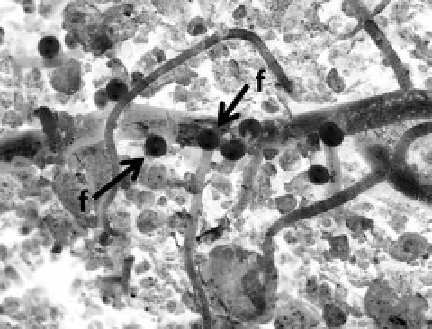Agriculture Reference
In-Depth Information
species. At least six
Meloidogyne
species are con-
sidered to be of global economic importance as
potato pests: in the tropics,
M. incognita
(southern
root-knot nematode) and
M. javanica
are widely
distributed and cause substantial damage (Scur-
rah
et al
., 2005), whereas,
Meloidogyne hapla
Chitwood, 1949 (northern root-knot nema-
tode),
Meloidogyne chitwoodi
(Golden, O'Bannon,
Santo and Finley, 1980) (Columbia root- knot
nematode) and
Meloidogyne fallax
Karssen, 1996,
are more important in temperate regions (Karssen,
1996).
M. chitwoodi
and
M. fallax
are quarantine or-
ganisms in Europe, and recently another species,
Meloidogyne minor
Karssen, Bolk, van Aelst, van
den Beld, Kox, Korthals, Molendijk, Zjilstra, Van
Hoof & Cook, 2004, has been described in north-
western Europe, which can cause severe quality
damage in potato (De Weerdt
et al
., 2011).
Meloid-
ogyne
spp can be disseminated by infested soil
adhering to farm machinery and in irrigation
water, but seed potato tubers are the most effi-
cient way to spread these nematodes to new areas.
Thus, RKNs are a permanent concern in the move-
ment of seed potato tubers to countries that have
quarantine restrictions for these species.
RKNs are sedentary endoparasites with
four juvenile stages. The females produce ~500 eggs;
the first-stage juvenile develops in the egg and
undergoes the first molt, giving rise to the sec-
ond-stage juvenile. This parasitic stage invades
near the root tips, induces the formation of giant
cells, and then begins feeding, undergoing three
molts until the adult stage. In both tubers and
roots, feeding sites are characterized by giant
cells containing granular cytoplasm and many
hypertrophied nuclei. Males can be present even
in parthenogenetic species, but they do not feed.
For
Meloidogyne
species, the aboveground
symptoms are not specific, and symptoms can
occur in patches of reduced growth with plants
that are stunted with chlorotic leaves and wilt-
ing, particularly with moisture stress. Complete
plant loss can occur with high infestations. How-
ever, infestations may occur without causing any
aboveground symptoms, mainly in potato crops
that receive high levels of fertilizers. Roots in-
fected by
M. incognita
or
M. javanica
can exhibit
large characteristic galls. However, roots infected
by
M. chitwoodi
and
M. fallax
have very small
galls, while those infected with
M. hapla
may
show more evident galls and a proliferation of
lateral roots around the galls.
M. minor
also
causes similar symptoms on tubers to
M. chitwoodi
Fig. 10.1.
Females of
Globodera pallida
(f)
on roots of Desiree potato. (Photo courtesy of
J.E. Palomares-Rius.)
associated with bacteria or fungi such as the wilt
fungus
Verticillium
. The presence of PCNs on
roots can be seen with the appearance of pinhead-
sized, white-to-yellow colored females around the
time of flowering. The life cycle takes ~
5-7
weeks,
depending on conditions such as soil temperature
and host genotype, and in some circumstances two
generations can occur within the growing season
(Vovlas, 1996). Both species are difficult to differ-
entiate morphologically; characters used are the
shape of the stylet knobs, which are smaller and
rounded in
G. rostochiensis
and more robust and hooked
in
G. pallida
, and
G. pallida
has a longer stylet. Cyst
characters are also used to distinguish between
PCN species and to distinguish PCNs from other
cyst nematodes (Fleming and Powers, 1998). Mo-
lecular tools provide valuable additional species
diagnostics, and various methods have been devel-
oped for species identification and quantification
(Reid
et al
., 2010) and within-species differentiation
(Plantard
et al
., 2008; Hoolahan
et al
., 2012). For
further information on PCNs, see Subbotin
et al
.
(2010). Recently
G. ellingtonae
has been described
from fields in Oregon and Idaho, USA which para-
sitizes potato (Handoo
et al
., 2012) and the ITS se-
quence has high similarity to a sample from Chile.
Root-knot nematodes,
Meloidogyne
spp.
The RKNs,
Meloidogyne
spp., are globally the most
economically important PPNs, particularly in
warm regions. Wide host ranges and the capabil-
ity of producing multiple generations within one
crop season can lead to severe damage from some

